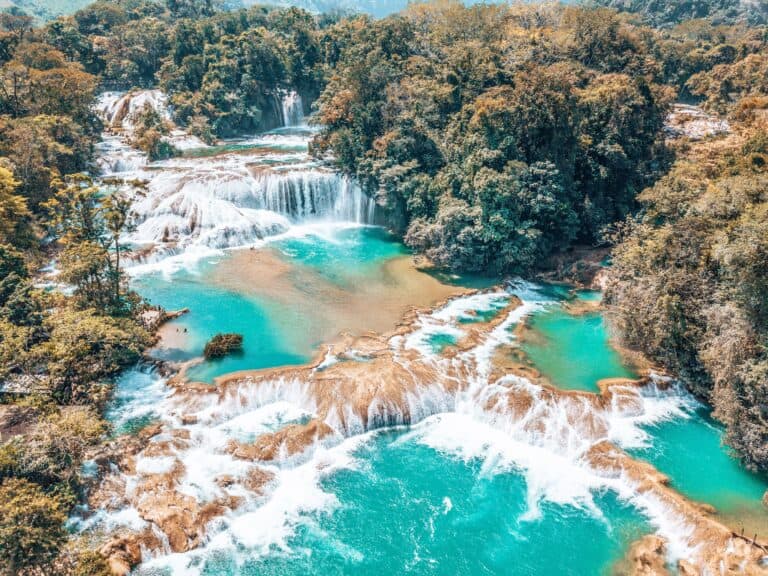
Ultimate Mexico City Guide
Explore Teotihuacan’s ancient archaeological ruins, eat mouth-watering street food, amble about the “green lungs” of the city in one of the picturesque parks, learn about Mexico’s history at the Anthropology Museum and float down peaceful waterways. There are many amazing things to do in Mexico City, continue reading our Mexico City guide for more!
Built on the ancient Aztec capital Tenochtitlan’s ruins, Mexico City is one of the oldest continuously inhabited cities in the Americas.
Mexico City is chaotic, magical and dynamic. It’s an intriguing blend of old and new with swanky restaurants rubbing shoulders with ancient Aztec ruins and chic bars popping up near ancient cultural sites.
It’s a bustling metropolis where you’ll find some of the world’s best street food, an iconic art scene, a rich and fascinating cultural heritage and huge spaces of gorgeous greenery. You’ll treasure a visit to Mexico City for a lifetime and it’s a great introduction to Mexico.
Given its size, it can be daunting to figure out where to start your planning, which is where I come in. In this Mexico City Guide, I’ll share the top things to do in Mexico City, how long and where to stay, the best time to visit, its safety and much more.
We have numerous Mexico guides, so if your visit to Mexico City is part of a larger trip, make sure you visit our blog posts below.
No time to read this Mexico City guide now? No worries, pin it for later!

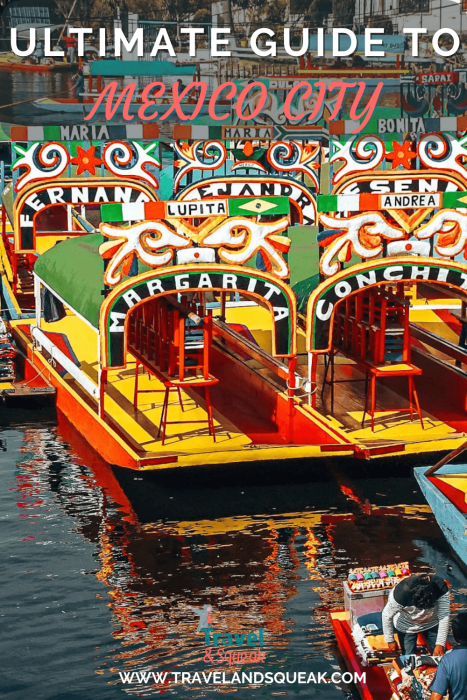
Best Things to do in Mexico City
Contents
Explore Mexico City's Historic Centre
I’m going to kick this Mexico City guide off with the city’s most defining neighbourhood, the Historic Centre. Centred around the massive Zocalo Plaza, this is Mexico City’s beating heart.
It’s vibrant, full of people and home to historic landmarks dating as far back as the Aztec era. You’ll also stumble upon iconic buildings, museums, captivating architecture, street vendors, high-end restaurants and basic taquerias.
The Zocalo is one of the most famous Mexico City attractions and one of the largest public plazas in the world! Flanked by a huge flagpole bearing the Mexican flag, here, you can see the birth of the nation and the defining characteristics of the two cultures that defined the city.

Prior to the Spanish invasion, the Zocalo was the principal ceremonial site for the Aztecs. Built in 1325, the Templo Mayor (Main Temple) was the centre of Tenochtitlan. However, during the Spanish conquest in 1521, it was destroyed and a cathedral was built in its place. The stone ruins lie at the heart of the historical centre and are an important archaeological site you can visit.
Today, the Zocalo remains an important political and cultural hub with some must-see attractions I’ll discuss throughout this Mexico City guide.
Visit the Floating Gardens of Xochimilco
Next in this Mexico City guide is visiting the Venice of Mexico; one of my favourite things to do in Mexico City.
The Floating Gardens of Xochimilco are miles of waterways, called chinampas which were an agricultural technique used by the Aztecs to turn swampy areas into farmland. In 1987, Xochimilco was designated a UNESCO World Heritage Site and its surrounding neighbourhoods still ooze tradition and respect for nature.
You’ll explore the canals on vibrant and colourful boats called trajineras. During the tour, you’ll pass other boats selling food and drinks and others with mariachi bands who’ll offer to play you a few songs and liven up your day!

The Floating Gardens of Xochimilco are one of the top Mexico City attractions and are a great way to meet locals, see some beautiful scenery outside the city, try some local food and learn about the history of the area.
Our top tip: request to visit Isla de las Munecas (Island of the Dead Dolls), an eerie plot of land where dolls are hung from trees. This site is a tribute to a young girl who tragically drowned in the canal. A local man started hanging up dolls in her memory; it was never meant to become a tourist attraction.

Roam Chapultepec Forest
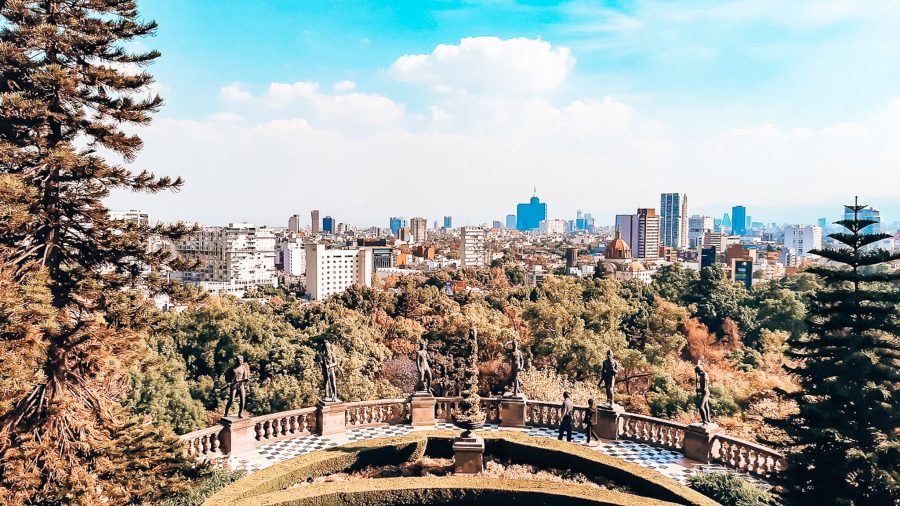
Chapultepec Forest is divided into three sections with the first being the oldest and most visited. In addition to the Chapultepec Castle, you’ll also find the Chapultepec Zoo, the Anthropology Museum, the Modern Art Museum and a lake with boats for rent.
The second section houses a large amusement park, numerous museums, restaurants and fountains and the third section is mostly made up of natural wooded areas and wildlife.
Strolling around this Mexican oasis is one of the best things to do in Mexico City to escape the city’s hustle and bustle and midday heat. Find a shady tree to sit under, read a book, watch the world go by or appreciate the beauty of the gardens.
Museum of Anthropology
The ground floor is dedicated to pre-Hispanic Mexico, while the upper floor showcases how Mexico’s indigenous descendants live today. It’s best to start in the rooms on the right as you enter the museum and go round anti-clockwise. These halls show how the earliest settlers arrived and developed over time from hunting life to farming in Central Mexico.
As you make your way around, you’ll eventually reach the hall devoted to the Mexica, or Aztecs. This room is full of magnificent stone sculptures including the famous sunstone which was unearthed beneath the Zocalo in 1790.
Some other highlights in the museum include two stone Olmec head carvings, a full-scale replica of King Pakal’s tomb discovered in the Templo de las Inscripciones at Palenque and a Jade mask of the Zapotec Bat God in the Oaxaca exhibit room.
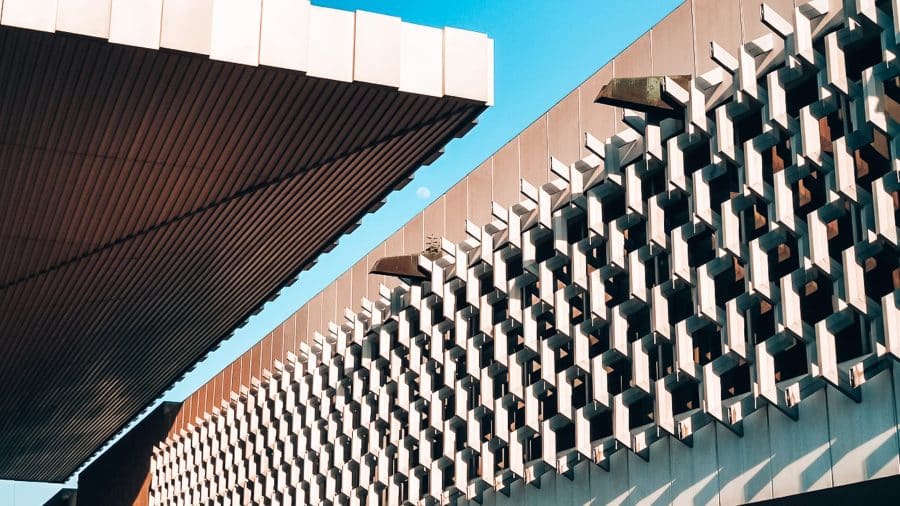
The museum is built around a large courtyard, which is a lovely place to sit and take a break if needed.
Visit Palacio de Bellas Artes
The Palacio de Bellas Artes is one of the most popular Mexico City attractions. Loved by both tourists and locals alike, this magnificent white marble palace is a prominent cultural centre in Mexico City.
The palace is located in the city’s historic centre and has hosted many momentous music, theatrical, dance, opera and literature events. It’s also played host to important photography, sculpture and painting exhibitions.
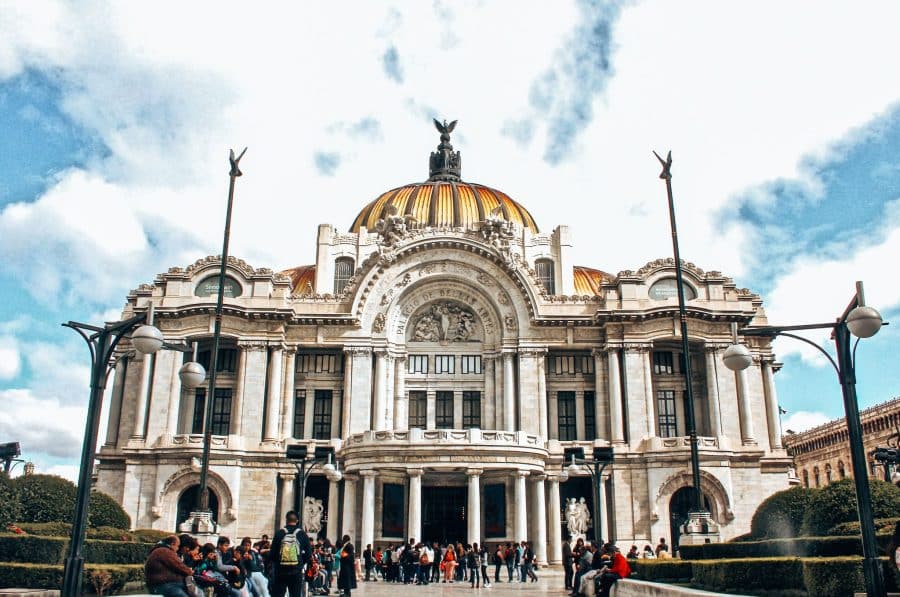
The Palacio de Bellas Artes was the first art museum in Mexico. Construction began in 1904, however, due to problems building on the subsoil resulting in the marble shell sinking and also delays due to the Mexican Revolution, the museum wasn’t completed until 1934.
The exterior of the building is primarily Art Nouveau and Neoclassical with the interior primarily Art Deco. Inside the palace houses a collection of significant murals created by world-renowned Mexican artists.
Stroll Around Parque Mexico
You won’t usually find Parque Mexico in Mexico City guides, however, I accidentally stumbled upon this charming park while on a run one morning and thought it deserved a mention as it was one of my favourite places in the city.
Parque Mexico is located in the upscale Condesa neighbourhood and is popular with locals out dog walking, working out, skateboarding and socialising with friends and families.
Parque Mexico was built in 1927 and is also known as the ‘lungs’ of Condesa. It’s one of the loveliest green spaces in the city with winding pathways leading to fountains, quaint benches and ponds.
It’s surrounded by Art Deco buildings and within the park are some impressive stand-out pieces. Most notable are the elaborate blue and white clock tower and the Foro Lindbergh made up of five pillars decorated with murals and a pergola.

Eat Delicious Street Food
Street food in Mexico City is an essential part of daily life. You’ll find food vendors everywhere selling everything from fresh fruit juices to sandwiches to tacos to tamales to full platters of food.
Mexican food is renowned for being spicy, vibrant and flavourful. Corn and beans are staples in almost every dish. Corn is eaten in many forms including tortillas, tacos, enchiladas, quesadillas and tostadas. Beans are usually refried and eaten either as an accompaniment with whatever form your corn is taking or as the main ingredient if you don’t eat meat.
One of my favourite street food items is tamales; steamed, corn-husk-wrapped pockets of masa stuffed with chicken, pork or cheese. They’re an ideal grab-and-go bite and particularly popular at breakfast.

There are countless types of tacos but the basis of them are usually corn tortillas filled with either chicken, beef, pork, seafood or refried beans and then barbequed, roasted on a spit, cooked on a griddle or stewed. Cheese, spring onions and beans are common additions. You’ll have the choice of both green and red salsa and maybe also an avocado-based salsa.
Corn is also a very popular street food snack in Mexico City. It’s topped with a spicy mixture of mayonnaise, cream, chilli powder and sprinkled with cheese (go with it, it’s actually delicious!).
One of the best things to do in Mexico City is a street food tour with a local guide as they’ll take you to the best spots where locals eat and you’ll get to try authentic and traditional Mexican food.

Explore Teotihuacan
Mexico is a fascinating country to visit for history lovers as it’s packed with ancient UNESCO World Heritage Sites. The most popular ones include Chichen Itza; one of the greatest Mayan centres of the Yucatan Peninsula, Palenque; one of the most documented Mayan archaeological ruins and Monte Alban; one of the earliest Mesoamerican cities (located in Oaxaca).
Approximately 50 kilometres north of Mexico City lies Teotihuacan; one of the most popular cultural centres in Mesoamerica and once the largest city in Mexico. This holy city, translated as ‘the place where the Gods were created’, is characterised by the vast size of its monuments laid out on geometric and symbolic principles.
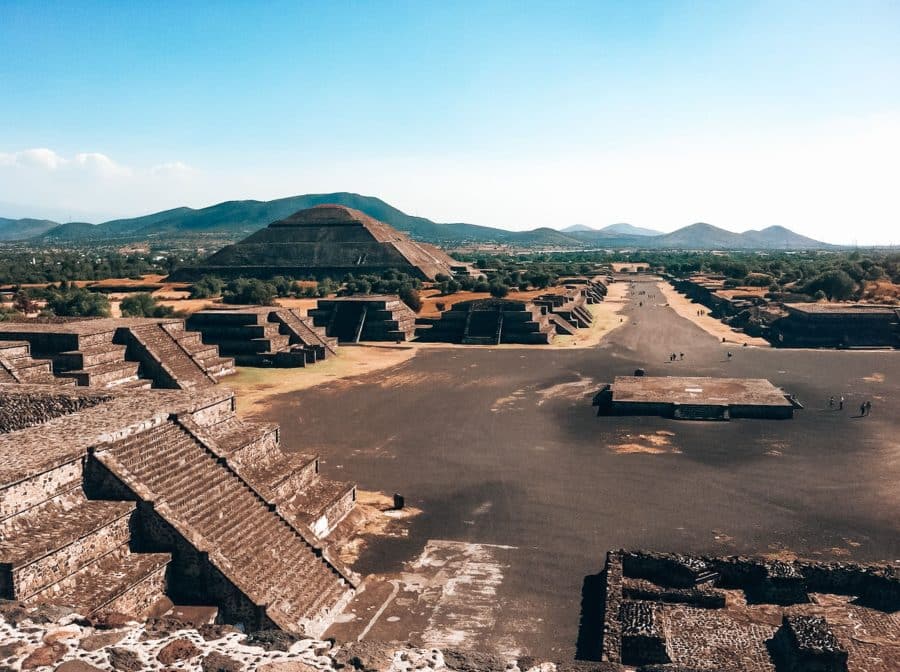
The city was settled as early as 400 BC and by 400 AD it had become the most powerful and influential city in the region. At its largest, it’s estimated the city’s population was between 150,000 and 250,000.
The Aztecs named it Teotihuacan when they found it in the 1400s, however, the city had been abandoned for centuries. Teotihuacan’s history, origins and culture largely remain a mystery.
The archaeological ruins are incredibly impressive. When I visited, you could still climb the Pyramids of the Sun and Moon for wonderful views over the Avenue of the Dead, however, as of 2022 this has been stopped.
Visit the Angel of Independence
The Angel of Independence, or more commonly, ‘El Angel’, is one of the most recognisable landmarks in Mexico City. Built in 1910, it’s a victory column located in the Historic Centre commemorating the hundredth anniversary of the beginning of Mexico’s War of Independence.
It subsequently became a mausoleum for the most important heroes of that war and today, it’s a common meeting point for both celebration and protest.

Watch a Lucha Libre Fight
I’m going to finish this Mexico City guide off with one of Mexico’s funniest traditions; watching a Lucha Libre fight
Every Tuesday, Friday, Saturday and Sunday evening, people line up to celebrate this spectacle. Lucha Libre has a long-standing tradition and is an integral part of Mexican culture. It has the second-highest spectator rate after football in the country so, as you can see, it’s pretty popular!

It involves colourful masks, hundreds of sequins, extravagant personalities and very tight spandex…what’s not to love?! This was definitely the most surreal experience I had in Mexico and would 100% recommend experiencing it for yourself. Grab a beer and prepare for the atmosphere to get rowdy. You won’t be forgetting this evening any time soon!
How do I Get Around Mexico City?
Most of the top things to do in Mexico City are within walking distance, however, the city is huge and you’ll no doubt find yourself needing to use public transport at some point.
The best way to get around Mexico City on a budget is the metro. The metro spans most of the city, trains run every few minutes and costs just 5 pesos per trip. Services start at 5am weekdays, 6am Saturdays and 7am Sundays until midnight.
Our top tip: there’s a separate carriage for women and children which, if you’re a solo female traveler may make you feel safer.
Another way to get around Mexico City is on the Metrobus. Services run from 4:30am Monday – Saturday and 5am on Sunday until midnight. Trips cost 6 pesos and it’s free to transfer to other lines in the Metrobus network within two hours of initially tapping on. You’ll need to purchase a smart card as it doesn’t accept paper tickets.
Our top tip: purchase a smart card (10 pesos) on your first day in Mexico City as you can top it up once and use all types of transport in Mexico City.
One of the best ways to get around Mexico City is the bike-share system EcoBici. You’ll need to create an account online and you can register for one, three or seven days or buy an annual pass. There are over 600 stations around the city and over 9000 bikes available. This is a great and super convenient way of getting around Mexico City and a great way of seeing the city.
Rideshare is also widely used in Mexico City with Uber and DiDi which can be a good option if you’re travelling on your own in the evenings. Taxis are also available although more expensive and there are a lot of unregistered taxis who try to rip tourists off.
I’d recommend using a rideshare before a taxi and if you do need to take a taxi, try and order from inside a business such as a shopping mall or hotel rather than hailing off the street.
Where Should I Stay in Mexico City?
Mexico City is vast with many neighbourhoods so deciding where to stay can be quite daunting. In this Mexico City Guide, I’ll share a couple of my recommendations and I’ll also mention a couple of other areas as where to stay in Mexico City depends on the experience you’d like.
I’d recommend staying in La Condesa or Roma. They border each other with a short walk through the picturesque Parque Mexico. They fell into disrepair after the 1985 earthquake, but over recent years have been rediscovered by artists, designers and the younger generation lured in by the neighbourhood’s historic charm.
La Condesa is one of the most fashionable districts with a laid-back bohemian vibe. The beautiful Art Deco buildings lining the tree-lined streets are full of swanky bars, restaurants, some of the city’s best cafes and designer boutiques. The city’s best nightlife is also here with some interesting mezcal bars.
Roma is considered Mexico City’s arts district with many galleries and bookstores located in some of Roma’s original buildings that remained standing after the earthquake. It’s a gorgeous mix of old and new with modern glitzy buildings standing next to Art Deco mansions.
There’s always something going on with bars, restaurants, cafes and hipster shops on every street.
To be in the heart of the old town, Centro Historico is a great place to stay in Mexico City. Centro Historico is centred around the giant Zocalo where there are a number of colonial buildings, ancient ruins and lovely restaurants for the evening.
For Mexico City’s best restaurants and art galleries, the beautiful district of Polanco is your best bet. Polanco is also one of Mexico City’s busiest districts and one of the best areas for high-end shopping. It does come with the price tag so bear this in mind.
Finally, Colonia Juarez is a rather hipster area home to an increasing number of chefs, designers and artists. This has led to some of Mexico City’s best restaurants, bars and independent boutiques that don’t come with the price tag of areas such as Polanco.
How Long Should I Spend in Mexico City?
For this Mexico City guide, I’d recommend at least 3 full days. Any less and you won’t scratch the surface. You could easily spend a couple of weeks here and continue uncovering new gems and areas you’ve not visited before.
Allow for a full day to explore Teotihuacan and half a day for the Floating Gardens of Xochimilco. The other top things to do in Mexico City can be seen in a couple of days.
When's the Best Time to Visit Mexico City?
Spring and autumn are generally the best time to visit Mexico City with warm days and cooler evenings. Summer is Mexico’s rainy season and although this is more likely to affect the coast, you may still experience some heavy rain. In the winter, temperatures can drop considerably.
Is Mexico City Safe?
In recent years, Mexico City’s government has increased security patrols in most areas and the city is generally safe, however, as with all big cities there are precautions to take and areas to avoid.
Tourist areas and everywhere mentioned in this Mexico City guide are largely safe but always keep valuables close and hidden, don’t wander quiet back streets alone at night and be wary of scams.
Here is a great guide to safety in Mexico City with areas to avoid as well as common scams to watch out for.
Everything Else You Need to Know For This Mexico City Guide
How expensive is Mexico City?
Mexico City is very affordable and incredible value for money. Obviously, it depends on your budget and level of luxury but a street food meal can be as little as $1, with snacks often costing less. In restaurants, meals start from around $8 and work their way up depending on the type of restaurant.
Dorms in hostels start from around $10 a night and hotels from $18 for a basic room. Luxury hotels start from around $50 a night.
These prices are based on low-season.
Do I need a visa to visit Mexico City?
What currency is used?
Mexico uses the peso. At the time of writing 1 USD is 17.29 MXN.
What plug do I need?
Mexico uses plug types A and B. Both have two flat parallel pins and B has a grounding pin.
I hope this Mexico City guide has been useful in helping you plan your trip. If you have any questions or just want to say hi, feel free to leave a comment or contact us 🙂

